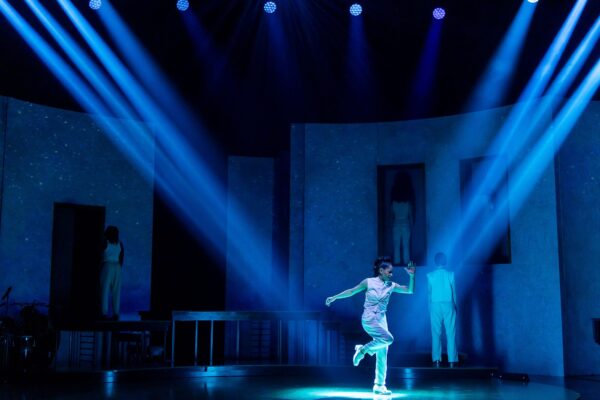TAP INTO JOY AT A.R.T.
I felt the first chills early in Diary of a Tap Dancer. It was during an ensemble number set in the Bronx and the birth of hip hop – I got that feeling in my solar plexus which told me this was a show bound for great things. That feeling recurred throughout last night’s world premiere opening of multi-talented dancer and choreographer Ayodele Casel and director Torya Beard’s exciting production at A.R.T. And I wasn’t alone. You could sense that viewers also knew this innovative production is slated to become a classic.

Ayodele Casel
Part autobiography, part history, and all entertainment, Diary of a Tap Dancer is both unique and very much of the moment. Working with a team of seven other virtuoso female and nonbinary tap dancers (Naomi Funaki, Afra Hines, Quynn L. Jonson, Funmi Sofola, Liberty Styles, Annaliese Wilbur, Ki’Leigh Williams), Diary crackles with a variety of dance and musical styles as Casel presents the story of her life from her early years in the Bronx to what initially seems like an exile of five years to her grandparent’s home in Puerto Rico and then her return, at the age of 15, to New York. Despite a girlhood crush on dancer Ginger Rogers, Casel did not begin tap dancing until she was a student at N.Y.U. Though it came late, her discovery of tap hit her hard, and she was immediately obsessed – practicing for hours each day in multiple environments, including subway platforms, where she drew small crowds of onlookers.
Liberty Styles and Ayodele Casel
Despite Casel’s dedication to her art, she hits numerous roadblocks, primarily because of the dominance of men in the field of tap and because her dance style was perceived as too masculine. Nonetheless, she persisted, and in the course of her efforts to find a way forward for herself, she discovered a rich vein of predecessors – women who beat out a rhythm as they danced, many of them Black. Some of these women found themselves cut out of films or stage productions because they won more applause than their male counterparts, or in the case of those who were Black, than white women.
The Cast
While the dancing is at the center of this remarkable production, a lot of other factors contribute to its power. Early in the show, a blue light casts visible rays over the audience. The light isn’t blinding, but it makes the stage invisible as we hear the building rhythm of tap on the boards. That’s just the beginning of multiple instances of the innovative lighting (Brandon Stirling Baker). Costumes (Camilla Dely) range from baggy sweats to white tailcoats as music evolves from hip hop to salsa to classic Gershwin and genres I can’t categorize (Carlos Cippelletti, piano; Paul Reyes Bueno, bass; Keisel Jimenez Leyva, drums). Again and again, it was a delight to see women dancing in trousers and shirts that allowed them to move freely and let us see their supple strength, not in clothing designed to show off their legs, breasts, or bottoms. Katherine Freer’s textured and colorful projections transcend the need for set changes beyond the black box style steps and risers designed by Tatiana Kahvegian that allow the musicians to remain on the stage throughout the show.
Ayodele Casel
The wonderful thing about live theater is that it’s always under development, and I hope there will be some tweaks to this production. The narrative gets a little lost in the second act. Casel draws a connection between modern tap dance and the types of rhythmic communication and expression employed by enslaved people barred from other types of interaction, arguing that dance is liberation. Then she makes the transition from her own professional challenges to her growing awareness of the many, many women who preceded her in the field, including the chorus line dancers of the Apollo Theater who led the first strike of Black performers and succeeded in winning higher wages, paid vacation time, and a shorter workday. This is fascinating stuff, but it takes a little too long to get to it, as though Casel felt she had to explain why she found the lives of these women important enough to seek them out.

Ayodele Casel
By this point in the show, it is enough for us to have seen and heard the beauty of these tap performers, especially when they perform together, their bodies moving in tandem, the swing of their arms and the drumming of their feet making the joy of their dancing and the significance of those who blazed the trail to make their dancing possible perfectly clear. Honestly, I had little interest in tap dancing before seeing this show, but the exuberance of these performers, as well as Casel’s ability to connect this medium to larger social and historic events, had me hooked. Early on, Casel explains that her name Ayodele is from a Nigerian word that means “joy has arrived.” Casel and her many collaborators have certainly brought joy to the stage with this soul-warming, edifying, and simply gorgeous production.
The Cast
photos by Nile Scott Studios and Maggie Hall
Diary of a Tap Dancer
American Repertory Theater (A.R.T.)
Harvard University
Loeb Drama Center in Harvard Square, 64 Brattle St in Cambridge
ends on January 4, 2025
for tickets (from $35), visit A.R.T.


{ 1 comment… read it below or add one }
Not sure why the Copacetics are not mentioned or Charles “Honi” Coles or the Shim Sham girls. The Hudson Valley, and Brenda Bufalino of Gardner near New Paltz, was for a time a revivalist center for tap and close to the home of Clayton “Peg Leg” Bates. I may be missing something from this review, or not. Many great tap dancers — whether or not they were Black — made their mark and should be remembered!